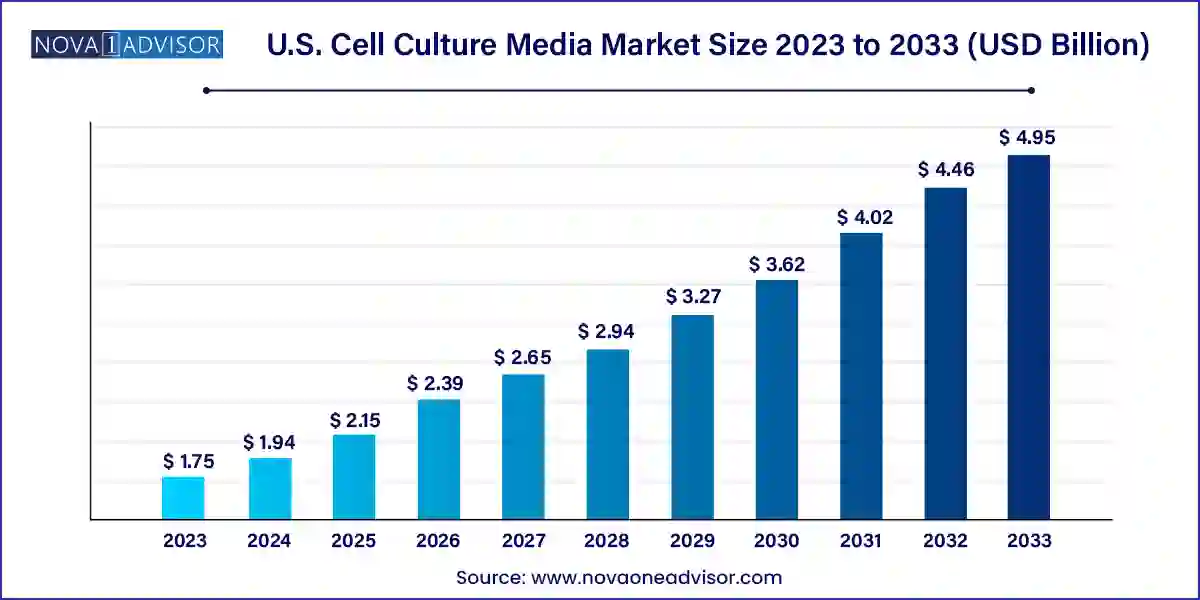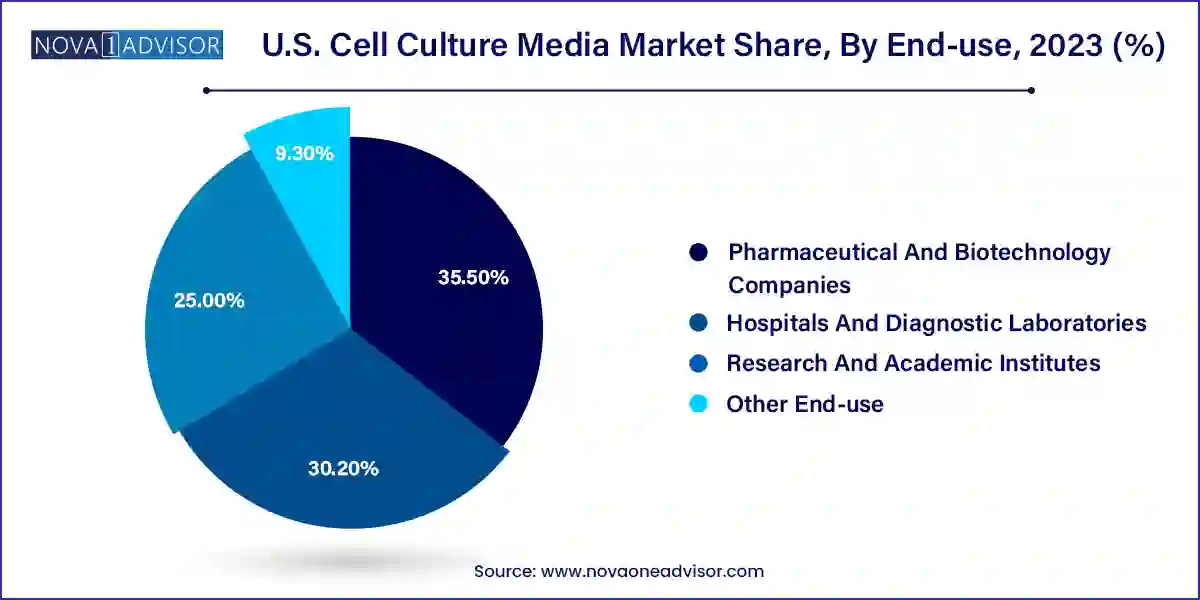The U.S. cell culture media market size was exhibited at USD 1.75 billion in 2023 and is projected to hit around USD 4.95 billion by 2033, growing at a CAGR of 10.96% during the forecast period 2024 to 2033 owing to continuously increasing use of cell culture technology. Furthermore, increased awareness about stem cells is driving the use of gene and cell therapy.

Key Takeaways:
- The serum-free media segment witnessed the highest revenue share of 37.20% in 2023.
- The biopharmaceutical production segment registered the highest revenue share of 43.00% in 2023.
- The liquid media segment witnessed the highest revenue share of 63.2% in 2023.
- The semi-solid and solid segment is expected to register a considerable CAGR from 2024 to 2033.
- The pharmaceutical & biotechnology segment registered the highest revenue share of 35.5% in 2023.
- Hospitals & diagnostic laboratories segment is expected to register a considerable CAGR from 2024 to 2033.
Market Overview
The U.S. cell culture media market has emerged as a critical segment in the life sciences and biotechnology sector, serving as the foundation for a wide variety of biomedical applications. Cell culture media are formulations designed to support the growth, proliferation, and differentiation of cells in controlled laboratory environments. These media are used extensively in pharmaceutical manufacturing, vaccine development, stem cell research, and regenerative medicine. With the rise in chronic diseases, expansion of biologics, and the surge in precision medicine, the market has gained substantial momentum.
As of the past few years, the U.S. has remained at the forefront of global cell culture innovations. Research institutions, biotechnology startups, and pharmaceutical giants have invested heavily in the optimization of culture conditions and the development of chemically defined and serum-free media to enhance reproducibility and scalability. Furthermore, government initiatives aimed at strengthening biopharmaceutical capabilities, such as Operation Warp Speed, have underscored the vital role of cell culture systems in vaccine production, thus accelerating the domestic demand for high-quality culture media.
The U.S. cell culture media market is characterized by its sophisticated infrastructure, a high concentration of R&D centers, and the presence of numerous academic institutions and biotechnology firms. These factors combine to create a thriving ecosystem that supports continued growth and innovation in cell culture methodologies.
Major Trends in the Market
-
Rapid Adoption of Serum-Free and Chemically Defined Media: Increased regulatory scrutiny and concerns about animal-derived components have driven a shift toward serum-free and chemically defined media.
-
Growth of Cell and Gene Therapy Applications: Advanced therapies like CAR-T cell therapy are expanding, necessitating specialized media tailored to unique cell lines.
-
Customization and Media Optimization: There is growing demand for tailor-made media solutions that cater to specific cell types and production goals.
-
Integration of Automation and Bioprocessing: Automated bioreactors and lab-on-chip devices are being integrated into cell culture systems for better efficiency.
-
Surge in 3D Cell Culture Techniques: 3D culture platforms for tumor models and tissue engineering are gaining popularity, which requires next-generation media formulations.
-
Sustainability and Ethical Sourcing: Environmental and ethical considerations are pushing the industry towards cruelty-free and sustainable sourcing.
-
Collaborations Between Academia and Industry: Partnerships are fostering faster development of media suited for novel applications like organ-on-chip systems.
| Report Coverage |
Details |
| Market Size in 2024 |
USD 1.94 Billion |
| Market Size by 2033 |
USD 4.95 Billion |
| Growth Rate From 2024 to 2033 |
CAGR of 10.96% |
| Base Year |
2023 |
| Forecast Period |
2024-2033 |
| Segments Covered |
Product, Application, Type, End-use |
| Market Analysis (Terms Used) |
Value (US$ Million/Billion) or (Volume/Units) |
| Regional Scope |
U.S. |
| Key Companies Profiled |
Sartorius AG; Danaher Corporation; Merck KGaA; Thermo Fisher Scientific, Inc.; FUJIFILM Corporation; Lonza; BD; STEMCELL Technologies; Cell Biologics, Inc.; PromoCell GmbH |
Key Market Driver: Expansion of Biopharmaceutical Production
The single most significant driver for the U.S. cell culture media market is the explosive growth of the biopharmaceutical industry. Biologics, including monoclonal antibodies, recombinant proteins, and vaccines, have seen robust demand across a wide range of therapeutic areas such as oncology, immunology, and infectious diseases. Cell culture media serve as a backbone in the upstream bioprocessing of these products. As companies like Amgen, Genentech, and Pfizer expand their bioproduction facilities within the U.S., there is parallel growth in the requirement for high-quality and high-yield culture media.
For instance, the development and mass production of COVID-19 vaccines using mRNA platforms involved large-scale cell culture processes. Companies like Moderna relied heavily on optimized media to ensure efficient production. Moreover, the emphasis on localized manufacturing and reducing dependence on foreign supply chains has encouraged domestic media production, further fueling market demand.
Key Market Restraint: High Cost of Specialized Media
Despite promising growth, the market is restrained by the high cost associated with specialized and customized cell culture media. Serum-free, chemically defined, and specialty media often come with higher production costs due to complex formulations and rigorous quality control standards. This becomes a significant barrier, especially for smaller biotechnology firms and academic research institutions operating under limited budgets.
Additionally, maintaining consistency and reproducibility while scaling up production adds to the overall cost burden. The dependency on imported raw materials for media components further complicates cost structures and supply chain stability. Although innovation is helping to reduce costs gradually, price remains a key challenge in broader adoption.
Key Market Opportunity: Advancements in Regenerative Medicine
Regenerative medicine, particularly cell and gene therapy, represents a transformative frontier in the U.S. healthcare landscape. As therapies based on induced pluripotent stem cells (iPSCs), mesenchymal stem cells (MSCs), and other advanced cell lines advance toward commercialization, the need for specialized culture media that can maintain cell viability, identity, and potency becomes critical.
For example, the approval of FDA-regulated therapies like Luxturna and Zolgensma has set the precedent for the future of gene therapy. These treatments rely on precision media for vector production and cell expansion. Startups and academic centers involved in personalized medicine and regenerative applications represent a key growth area, creating an avenue for innovative and cost-effective culture media tailored for human cells and tissues.
Serum-free media dominated the U.S. cell culture media market due to its widespread use in both research and industrial-scale production. CHO (Chinese Hamster Ovary) media, a subset of serum-free media, is particularly favored in the manufacturing of monoclonal antibodies and recombinant proteins. The ability to eliminate animal-derived components while ensuring high reproducibility makes serum-free media the go-to choice for regulatory-compliant applications. CHO media alone accounts for a significant share, largely due to its role in the production of blockbuster drugs like Rituxan and Herceptin.
Chemically defined media is the fastest-growing segment, driven by rising demand for consistency and compliance in biopharmaceutical manufacturing. These media are free from proteins and undefined components, making them ideal for high-throughput screening, automation, and quality control. The growing use of chemically defined formulations in stem cell research and tissue engineering is expected to propel this segment at an accelerated pace over the next decade.
Biopharmaceutical production was the leading application segment and continues to dominate due to the sheer volume of biologics produced in the U.S. Monoclonal antibodies take the lion’s share, with companies like Regeneron and Amgen relying on optimized media to streamline upstream processing. Vaccine production is also significant, with cell culture-based influenza vaccines and viral vector-based COVID-19 vaccines amplifying media consumption across specialized manufacturing facilities.
Tissue engineering and regenerative medicine is the fastest-growing application segment. The surge in demand for iPSC-derived tissues, CAR-T cell therapies, and 3D-bioprinted organs necessitates customized and high-performance media. The dynamic nature of this field and its potential to revolutionize patient care make it a lucrative opportunity for media developers. Furthermore, increased funding for NIH-sponsored research and clinical trials is supporting media innovation in this area.
Liquid media remains the dominant segment, primarily due to its extensive use in large-scale bioreactors and laboratory-based cell expansion. The ease of sterilization, adaptability to automation, and wide availability make it the most popular form across all end-users. Biopharmaceutical companies in particular prefer liquid formulations for their scalability and compatibility with continuous and fed-batch cultures.
Semi-solid and solid media is gaining traction, especially in niche applications like colony picking, tumor spheroid culture, and microbiological diagnostics. While still limited in industrial-scale usage, semi-solid media is essential in stem cell applications and cancer research, where precise localization and clonal isolation are critical.
Pharmaceutical and biotechnology companies dominate the market, accounting for the majority of media consumption. These companies require consistent and high-yield media to ensure the quality of therapeutic proteins and biologics. The rise of CDMOs (Contract Development and Manufacturing Organizations) in the U.S. further contributes to this dominance, as these entities invest heavily in scalable and robust media systems.

Hospitals and diagnostic laboratories represent the fastest-growing end-use segment, particularly in light of personalized medicine and rapid diagnostics. Culture-based testing, pathogen detection, and ex vivo cell analysis in hospital labs have become more prevalent, necessitating compact and ready-to-use media kits. Their role in clinical decision-making is expanding, especially in oncology and infectious disease testing.
Country-Level Analysis
The U.S. boasts one of the most advanced ecosystems for biotechnology and pharmaceutical innovation. With over 3,000 biotechnology companies and several globally renowned academic institutions like MIT, Harvard, and Stanford, the country is a hotbed for cell-based research. Federal funding through the NIH and public-private partnerships like the Biomedical Advanced Research and Development Authority (BARDA) support the continuous expansion of cell culture applications.
States like Massachusetts, California, and North Carolina lead in biopharmaceutical manufacturing, housing major R&D centers and GMP-certified facilities. The presence of manufacturing clusters, supportive regulations from the FDA, and tax incentives contribute to the vibrancy of the U.S. cell culture media market. Moreover, the post-pandemic push toward supply chain localization has encouraged domestic media production to reduce dependency on imports.
- Sartorius AG
- Danaher
- Merck KGaA
- Thermo Fisher Scientific, Inc.
- FUJIFILM Corporation
- Lonza
- BD
- STEMCELL Technologies
- Cell Biologics, Inc.
- PromoCell GmbH
Segments Covered in the Report
This report forecasts revenue growth at country levels and provides an analysis of the latest industry trends in each of the sub-segments from 2021 to 2033. For this study, Nova one advisor, Inc. has segmented the U.S. cell culture media market
Product
-
- CHO Media
- BHK Medium
- Vero Medium
- HEK 293 Media
- Other Serum-free media
- Classical Media
- Stem Cell Culture Media
- Specialty Media
- Chemically Defined Media
- Other Cell Culture Media
Application
- Biopharmaceutical Production
-
- Monoclonal Antibodies
- Vaccines Production
- Other Therapeutic Proteins
- Diagnostics
- Drug Screening And Development
- Tissue Engineering And Regenerative Medicine
-
- Cell And Gene Therapy
- Other Tissue Engineering And Regenerative Medicine Applications
Type
- Liquid Media
- Semi-solid And Solid Media
End-use
- Pharmaceutical And Biotechnology Companies
- Hospitals And Diagnostic Laboratories
- Research And Academic Institutes
- Other End-use


